
Visegrád is a castle town in Pest County, Hungary. It is north of Budapest on the right bank of the Danube in the Danube Bend. It had a population of 1,864 in 2010. The town is the site of the remains of the Early Renaissance summer palace of King Matthias Corvinus of Hungary and a medieval citadel.

The Hungarian State Opera House is a historic opera house located in central Budapest, on Andrássy út. Originally known as the Hungarian Royal Opera House, it was designed by Miklós Ybl, a major figure of 19th-century Hungarian architecture. Construction began in 1875, funded by the city of Budapest and by Emperor Franz Joseph I of Austria-Hungary, and the new house opened to the public on the 27 September 1884. Before the closure of the "Népszínház" in Budapest, it was the third largest opera building in the city; today it is the second largest opera house in Budapest and in Hungary.

The Budapest University of Technology and Economics, official abbreviation BME, is a public research university located in Budapest, Hungary. It is the most significant university of technology in the country and is considered the world's oldest institute of technology which has university rank and structure. It was founded in 1782.

The Grassalkovich Palace is a palace in Bratislava, Slovakia, and the residence of the President of Slovakia. It is situated on Hodžovo námestie, near the Summer Archbishop's Palace. The building is a Rococo-late Baroque summer palace with a French garden.
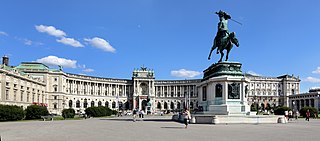
The Hofburg is the former principal imperial palace of the Habsburg dynasty in Austria. Located in the centre of Vienna, it was built in the 13th century and expanded several times afterwards. It also served as the imperial winter residence, as Schönbrunn Palace was the summer residence. Since 1946, it is the official residence and workplace of the president of Austria.

Buda Castle is the historical castle and palace complex of the Hungarian Kings in Budapest. It was first completed in 1265, although the massive Baroque palace today occupying most of the site was built between 1749 and 1769. The complex in the past was referred to as either the Royal Palace or the Royal Castle. The castle now houses the Hungarian National Gallery and the Budapest Historical Museum.

The Halászbástya or Fisherman's Bastion is one of the best known monuments in Budapest, located near the Buda Castle, in the 1st district of Budapest. It is one of the most important tourist attractions due to the unique panorama of Budapest from the Neo-Romanesque lookout terraces. The Fishermen's Bastion's main façade, parallel to the Danube, is approximately 140 meters long, of which the southern aisle is about 40 meters long, the north is 65 meters long, and the ornate central parapet is 35 meters long. Its seven high-pitched stone towers symbolize the seven chieftains of the Hungarians who founded Hungary in 895.

Alajos Hauszmann was a Hungarian architect, professor, and member of the Hungarian Academy of Sciences.

József Róna was a Hungarian sculptor and artist.
The architecture of Hungary is understood as the architecture of the territory of the country of Hungary, and in a wider, of the Kingdom of Hungary, from the conquest to the present day.
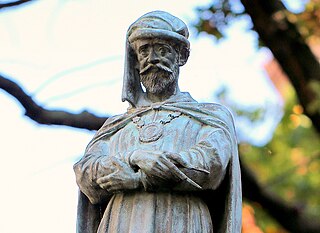
Samu Pecz was a Hungarian architect and academic.

The Palatinal Crypt in Buda Castle, Budapest is the burial place of the Hungarian branch of the Habsburg dynasty, founded by Archduke Joseph, Palatine of Hungary. It is the only interior part of Buda Castle which survived the destruction of World War II and was not demolished during the subsequent decades of rebuilding.
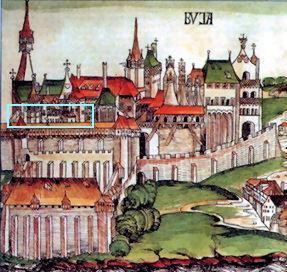
The Medieval Royal Palace of Buda Castle is a series of rooms from the old palace of the Hungarian kings, destroyed after 1686. Some rooms were unearthed and reconstructed during the postwar rebuilding of Buda Castle in 1958–62. The palace is now part of the permanent exhibition of the Budapest History Museum in "Building E" of Buda Castle.

Hungarian art stems from the period of the conquest of the Carpathian basin by the people of Árpád in the 9th century. Prince Árpád also organized earlier people settled in the area.

The Royal Palace of Gödöllő or Grassalkovich Castle is an imperial and royal Hungarian palace located in the municipality of Gödöllő in Pest county, central Hungary. It is famous for being a favourite place of the Queen of Hungary.
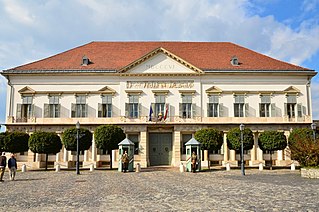
The Sándor Palace is a palace in Budapest, Hungary. Located beside the Buda Castle complex in the ancient Castle District, it has served as the official residence and workspace of the president of Hungary since 2003.
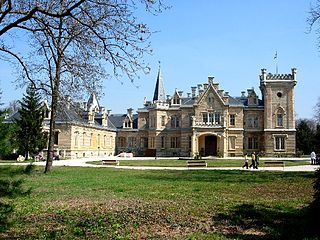
The Nádasdy Mansion is a Neo Gothic style manor house designed by István Linzbauer and Alajos Hauszmann situated on 24 hectares in Nádasdladány, Hungary. It dates from 1873 to 1876, and belonged to the Nádasdy family. It was used for the exterior of the vampires' mansion in the Underworld film series.

Matthias Fountain is a monumental fountain group in the western forecourt of Buda Castle, Budapest. Alajos Stróbl’s Neo-Baroque masterpiece is one of the most frequently photographed landmark in the Hungarian capital. It is sometimes called the ’Trevi Fountain of Budapest’.

The Castle Quarter refers to the part of Budapest located within the defensive walls of the Buda Castle complex, corresponding with the medieval royal city of Buda. Located on the Várhegy, it is the oldest part of Budapest.

Archduke Joseph's Palace is a former royal residence located on Castle Hill (Várhegy) in Budapest, Hungary. It was located next to Buda Castle. Currently, it is being reconstructed as part of a revival programme of the Buda castle hill.





















